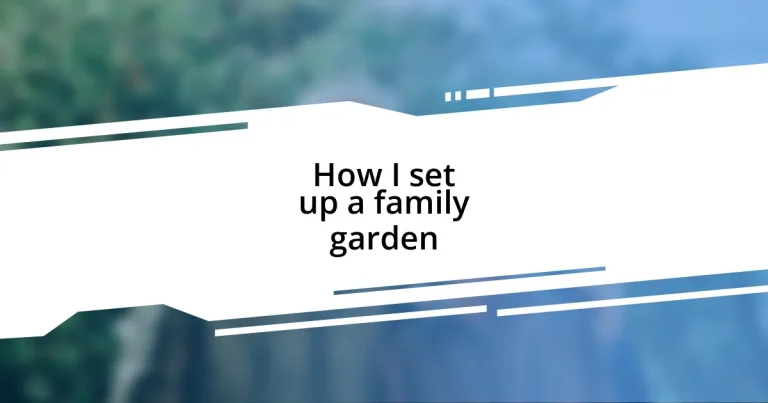Key takeaways:
- Select a sunny, accessible location with good soil quality and drainage for your family garden.
- Plan the garden layout, ensuring proper plant spacing and incorporating pathways for easy access.
- Choose plants based on climate compatibility, family preferences, and maintenance levels to reflect your family’s personality.
- Involve family members in gardening activities to build memories and teach valuable life lessons about care and responsibility.

Choosing the right location
Choosing the right location for your family garden is crucial. I remember my own excitement as I surveyed the yard, wondering where the sun would shine brightest and the rain would trickle down. I quickly learned that a sunny location, with at least six hours of direct sunlight each day, is essential for most plants to thrive. Have you ever noticed how much happier your flowers look when they catch those golden rays?
Consider the accessibility of your chosen spot, too. One year, I placed my garden too far from the kitchen, and I felt that distance with each trip I made to grab fresh herbs for dinner. It’s not just about beauty; you want to ensure you can easily reach your garden for easy maintenance and harvest. How convenient would it be for you to snip fresh basil or gather your veggies without trekking across the yard?
Finally, factor in the soil quality and drainage. I’ve found that a nice, loamy soil means less work for me down the line. I vividly recall my first attempt at gardening in a spot with heavy clay; the results were discouraging. After a bit of research, I moved my garden to a location with better drainage, and it made all the difference. Don’t skip this step—your plants will thank you later!

Planning your garden layout
Planning your garden layout can feel overwhelming, but it’s also an exciting opportunity to create a space that reflects your family’s needs. I once took a Sunday afternoon to sketch my ideas on a piece of paper, and I was surprised by how much clarity that brought. It’s amazing how visualizing plant placements helped me understand the flow of the garden, making it easier to envision what I wanted for that space.
When it comes to spacing, I learned the hard way that crowding plants can lead to a mediocre harvest. My first attempt at a vegetable garden featured rows haphazardly crammed together, resulting in a tangled mess that made it nearly impossible to identify what was growing where. Now, I carefully consider each plant’s mature size and allow sufficient room for them to spread out, both above and below ground. Have you experienced the joy of a bountiful harvest? It’s worth every inch of planning!
I’ve also found that incorporating pathways into the layout unexpectedly enhances the garden’s charm. Initially, I didn’t think much of it until I added stepping stones to my design. Suddenly, my garden became not only functional but also inviting. Pathways provide easy access and beautifully define different sections. So, as you layout your garden, think about how pathways can offer both practicality and aesthetic appeal.
| Layout Element | Consideration |
|---|---|
| Spacing | Ensure enough space between plants to avoid overcrowding. |
| Pathways | Include paths for accessibility and aesthetics. |
| Plant Height | Place taller plants to the north or back to prevent shading shorter plants. |

Selecting the best plants
Selecting the right plants for your family garden can transform an ordinary space into a vibrant oasis. I remember the thrill of deciding which varieties would best suit my family’s tastes and preferences. It felt like a treasure hunt at the local nursery—each plant was like a new possibility waiting to be discovered. I’m a firm believer that choosing a mix of familiar favorites and new delights keeps the gardening experience fresh and exciting.
As you dive into plant selection, consider the following factors:
- Climate Compatibility: Ensure your plants are suitable for your local climate. Researching hardiness zones made a significant difference in my garden’s success.
- Family Preferences: Think about what your family enjoys eating or flowers they love. I always include tomatoes and basil; they’re staples in our meals.
- Growth Patterns: Choose plants with varying heights and growth habits for visual interest (and for maximizing space!). I’ve learned that placing sprawling plants near supports helps keep everything tidy.
- Pollinator Friendliness: Incorporating flowers that attract bees and butterflies not only beautifies the garden but also enhances overall health. The first time I saw my garden buzzing with life, it brought me a sense of joy I never expected.
- Maintenance Level: Consider how much time you can dedicate to upkeep. I started with high-maintenance plants and soon realized I needed a mix with lower demands to keep my weekends enjoyable rather than exhausting.
By keeping these points in mind, you’ll create a garden that’s not just fruitful but also reflective of your family’s personality and lifestyle.

Preparing the soil effectively
Preparing the soil effectively is a crucial step that sets the foundation for a thriving garden. When I first started, I didn’t realize how important it was to really understand my soil type. I remember digging down into my yard and discovering a mix of clay and sandy soil that looked more like a brick than a nurturing base for plants. This revelation led me to research and eventually amend my soil to improve drainage and nutrient content, paving the way for healthier plants.
One of the best tips I’ve come across is to conduct a soil test. It might sound technical, but it’s straightforward and incredibly enlightening. I sent in a sample from my garden and learned about its pH levels and nutrient deficiencies. Armed with this information, I was able to add organic matter like compost and well-rotted manure, which made such a difference in the soil’s structure and fertility. Have you ever tasted a fresh tomato from a garden where the soil has been carefully prepared? It’s simply unbeatable!
Additionally, I firmly believe in the benefits of using cover crops. The first time I sowed clover to enrich my soil during the off-season, I was amazed by how much it improved the texture and fertility. Not only did it control weeds, but it also added nutrients when I tilled it in before planting. Preparing the soil is more than just digging; it’s about nurturing and creating a living environment for your plants. How do you prepare your soil to ensure a successful garden?

Setting up irrigation systems
Irrigation systems are the lifelines of a family garden, providing consistent moisture that helps plants thrive. When I first set up my garden, I opted for a drip irrigation system after researching its water efficiency. I remember the first time I turned it on; the gentle trickle felt like a small victory, knowing I was conserving water while ensuring my plants were happy.
One key benefit of drip systems is that they deliver water directly to the roots, minimizing evaporation and reducing weed growth. Initially, I worried about setting it up correctly, but laying out the tubing and adjusting the emitters turned into a satisfying weekend project. My family even joined in—turning it into a fun bonding activity, with plenty of laughs and dirt under our nails. It was rewarding to see our hard work translate into healthier plants.
Don’t overlook the idea of a timer when setting up irrigation; it’s a game changer for busy families. I can still recall the first time I programmed mine. The freedom of knowing that my garden would be watered at precise intervals made me feel like a gardening genius. Plus, it provided peace of mind, especially during those hot summer days when I couldn’t be outside tending to my plants. Have you ever considered how a small addition like this can save you so much time and worry? It truly was a revelation for my gardening routine!

Maintaining your family garden
Maintaining a family garden can seem daunting, but it’s truly rewarding. I remember those early days when my plants were struggling, and I realized that regular monitoring was essential. I started creating a weekly routine to check for pests and diseases. It became a family affair! Each weekend, I’d gather my kids to inspect the leaves and soil together, turning it into a little treasure hunt. Have you ever experienced that thrill of spotting a thriving vegetable or a beautiful bloom? It’s moments like these that ignite my passion for gardening.
One of the surprises I encountered was the importance of mulching. After I added a thick layer of straw to my flower beds, I was astonished by the difference it made. It not only helped retain moisture but also kept weeds at bay. In my experience, going out to admire my garden felt more pleasurable knowing I had taken steps to ease maintenance. I still remember when the vibrant colors of my flowers seemed to celebrate the mulching effort—what a sight that was!
And don’t get me started on the rewards of proper pruning! I once nervously trimmed my overgrown tomato plants, and to my amazement, the result was more sun exposure and healthier growth. It transformed my dusty harvest days into delightful culinary experiences, where I could whip up fresh salsa for family gatherings. Pruning may seem intimidating at first, but with a little practice, it becomes second nature. Have you considered how tackling these maintenance tasks can lead to such delectable rewards? It’s that cycle of effort and joy that keeps me going!

Involving the family in gardening
Involving the family in gardening adds a delightful layer to the experience. I remember the first time my kids each picked a plant to grow; their excitement was contagious. We started with simple herbs like basil and mint, which are not just easy to tend but also useful in our kitchen. Watching them water their plants, I felt a warmth in my heart, realizing we weren’t just cultivating a garden but building memories.
One Sunday, we turned our garden layout into an adventure, drawing a treasure map to mark where each plant would go. The giggles and creativity that flowed during that session created a sense of ownership for the kids. It became more than just planting seeds; it was about them understanding the journey of growth. Have you ever witnessed kids’ pure joy when they see their plants sprout? It’s a reminder of how nature can spark imagination and wonder.
Gardening, I’ve found, is an excellent opportunity for teaching valuable life lessons. When my daughter accidentally stepped on a young sunflower, we used it as a moment to discuss care and responsibility. It was a teachable moment that evolved into a conversation about compassion for all living things. Watching their enthusiasm for nurturing the garden grow year after year has been a rewarding experience. How often do we find opportunities to connect with our loved ones over simple, yet profound activities? Involving the family in gardening is not just about the plants; it’s about nurturing relationships too.














